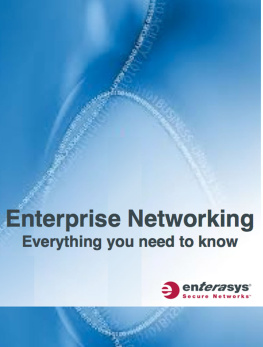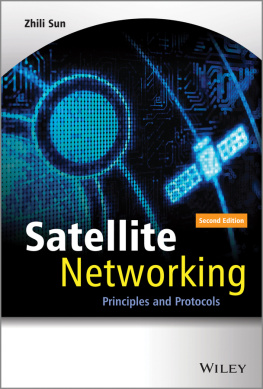Introduction to Enterprise Networking 
During the past 30 years, the acceptance and growth of high-performance corporate network systems and infrastructures have been prolific in South Africa - as they have been in the all countries.
Weve seen the development of open, standards-based networks that first made connectivity available to everyone. And weve experienced the rise in importance of the Internet followed rapidly by the advancement of social media from consumer fad and business pariah to corporate necessity.
Today were witnessing the adoption of cloud computing, one of the fastest growing trends in business whereby shared resources, software and applications are consumed by organisations on-demand from cloud-based service providers, much as we consume water or electricity supplied by a public utility company.
On-demand cloud services, including online collaboration tools and social networking platforms, are able to deliver speed, efficiency and marketing advantages to businesses over and above the obvious cost benefits which are said to be as high as 20 to 30% of total IT expenditure.
Many of the changes have been chronicled in the first and second editions of Enterprise Networking, a book that was first written in 2000 by my colleague and then UK counterpart at Cabletron Systems (now Enterasys Networks) David Palmer-Stevens.
Accepting the baton from David, I orchestrated an update together with a number of contributors. The revised edition was launched in South Africa in 2003. Eight years on, and the IT industry has gone through another dramatic revolution, demanding yet another update of the tome.
I am constantly amazed at the speed with which devices can communicate today compared to just a few years ago, boosted by ever-increasing bandwidth requirements of modern devices and applications.
Ten Gigabits-per-second (Gbps) was considered groundbreaking in 2003, but nowadays, out-the-box networking components can be configured to deliver 100 Gbps in wired or wireless form across the most complex corporate-wide infrastructures.
And as technology presses ahead, the cadence of the drumbeat to which it is marching is quickening. Already, all-optical computer chips, currently in the experimental stage, promise a future computing world based on light speed. In just a few short years well be measuring network speeds, even in garden-variety LANs, in Terabits-per-second. One Tbps equals 1000 gigabits. Is this the next frontier?
Over the past decade, a new generation of technologies has been born; Voice over
IP (VoIP) and other time-sensitive data mean that decreasing latency is as urgent as increasing speed. Now 99.999% uptime is considered the average network benchmark.
Whats more, the virtualised infrastructure and cloud-based revolutions have changed how servers, switches and client computers behave on the network, making management ever more challenging.
And the challenges keep on coming. Today, there is a growing army of mobile workers that demands access to every networked and Internet-based service from anywhere on the planet using their latest PC tablets, smartphones and laptop PCs.
But like any revolution, there are casualties. Security has become one of the most- discussed issues in todays corporate corridors of power. Companies making use of outsourced or hosted cloud services that often bypass the physical, logical and personnel security controls of traditional in-house systems are most vulnerable.
The IT research and advisory firm Gartner says smart customers should ask tough questions about security before committing to a network vendor. Addressing organisations looking to a cloud-based future, it counsels cloud converts to avoid vendors who refuse to provide detailed information on security concerns.
What exactly are these security issues? Privacy heads the list. It includes secure access when connecting to cloud services and it encompasses authentication/ authorisation and endpoint security validation.
Despite these uncertainties, overall security provided by cloud computing hosts and their associates has the potential to be as good as - if not better than - the security barriers common to most traditional computer systems, if addressed correctly.
Against this backdrop, making a smart IT decision these days means knowing a lot more about networks than their cost. Decisions have become a business-continuity prerogative and price has little relevance here. Performance is key.
For network managers and administrators, maintaining a competitive edge in the marketplace particularly in the light of new corporate governance requirements is vital. Failure could mean the difference between a fast-tracked promotion, or a slow walk to the HR department to collect severance pay.
These are some of the key reasons for the existence of this book. I believe Enterprise Networking is a valuable resource for anyone involved in networking, giving them a quick, high-level overview of the main technical and business issues. Hopefully its contents will help people who need an overview of the opportunities, the challenges and the trends in the modern networked computing field to make better decisions.
The first local edition of Enterprise Networking published proved gratifyingly popular. I believe this 2011 update will be equally as well received as it is readily available as an e-book, downloadable over the Internet.
Together with those at Enterasys Networks whose efforts contributed to the first edition, I was delighted when it becoming a standard reference work, found in almost any IT managers office. We were again pleasantly surprised when it assumed the role of an introductory text work in many technical colleges around the country.
Complying with our original mission, we have continued to keep the technical information non-partisan. Enterprise Networking is, therefore, a no-nonsense, no-hype and sales-free zone designed as a useful source of information, not a thinly-disguised product brochure.
Weve restructured the text to reflect the contrasting, and sometimes contradictory, worlds we live in the physical world of wires and antennas and switches and routers, the virtual world of broadband connections, and the new-age world of cloud-based networks and the on-demand consumption of computing resources.
So, I invite you to delve into Enterprise Networking and urge you to use the contact details below to let me know of your own experiences good, bad or exciting - in todays networked world.
Martin May
Regional Director (Africa) Enterasys Networks
Email:
Facebook: http://www.facebook.com/martin.may.enterasys
Youtube: http://www.youtube.com/user/mrmartinmay
Twitter:@MartinMay001
Linkedin: http://za.linkedin.com/pub/martin-may/19/609/415
+27 83 437 3823 www.enterasys.co.za www.enterasys.com
PART I
Chapter 1
THE CABLE FOUNDATION
The importance and current implementations of cabling systems for data networks is reviewed in this section. The relevant cable standards are discussed, and the final section is a quick reference for current cabling specifications for Ethernet installations.

THE CABLE FOUNDATION
The debate as to whether wireless local area networks (WLANs) are ready to replace cable-based LANs is not yet resolved. The technology driving WLANs is still in its development phase as opposed to cable-based LANs, which have reached a high level of maturity.

















